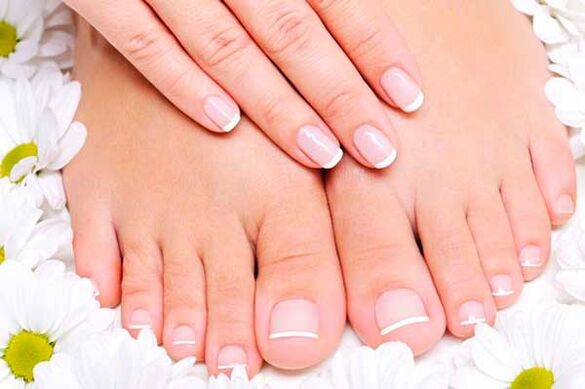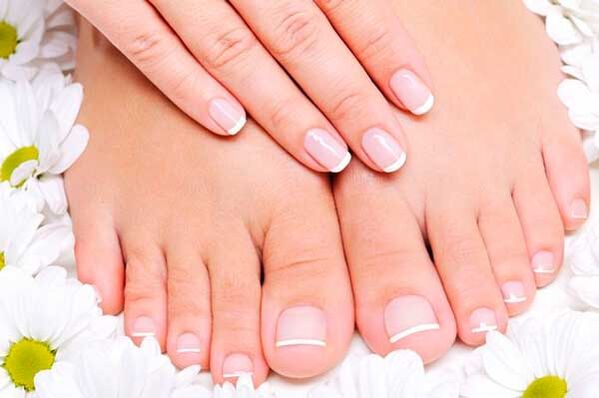
Toenail fungus is the most common and most unpleasant disease. Fungal infections of the feet and nails can not cause significant damage to health, but can weaken the immune system and cause unpleasant pain.
Nail fungus is able to accumulate toxic toxins in the body, multiplies during the growth of pathogenic fungi, resulting in slow poisoning of the body, can cause an allergic reaction or exacerbate chronic diseases. As a result, metabolic processes in the body are disrupted, immunity is reduced, the general physical condition deteriorates, sensitivity to various adverse effects of the environment increases.
In this article you will learn what fungal spores are, the causes of this unpleasant disease, signs and symptoms of damage, how to treat nail fungus at home, what preventive measures should be taken to prevent infection.
Why does fungal mycosis occur on toenails?
A fungal infection can be caused by:
- sores on the feet in the form of cracks and abrasions that can occur as a result of a pedicure procedure or as a result of wearing narrow, uncomfortable shoes;
- corns and calluses on the feet;
- poor irregular foot care;
- reduction of immunity;
- long-term use of antibiotics and drugs with similar effects on the body during treatment;
- excessive sweating of the feet;
Decreased immunity and protective functions of the body can lead to a fungal disease, but it is not a major factor in the onset of the disease.
First, the infection occurs:
- contact with a sick person, often a close relative, through the home road, through common slippers or shoes, household items - washing clothes, sponges, rugs;
- in the sauna, bath, pool and beach. A large crowd and a humid environment contribute to the spread of fungal diseases;
- wherever people walk barefoot. Spores of fungi can withstand sudden changes in temperature from very low to very high levels and remain for a long time in the sand, on the surfaces of sidewalks, on the upper surfaces of the pool;
- the survival and reproduction of pathogenic viral microflora when wearing someone else's shoes;
- wearing socks or stockings made of synthetic materials that do not allow air to pass through, creates a favorable microclimate for fungal infections;
- constant wearing of false nails makes it impossible for the nail plate to breathe, which contributes to mycosis infection;
Symptoms of fungal infections of the nails and feet
- dryness, itching, redness and peeling of the feet;
- the appearance of small itchy vesicles between the heel and toes, the formation of corns-corns is possible;
- appearance of diaper rash on the feet due to increased sweating;
- change in the shape and color of the nail. The spores of the fungus penetrate the nail plate and gradually take root there. The nail structure is heterogeneous and brittle with an uneven surface. Light or yellow spots appear at the sites of defeat, and the cavities beneath them;
- under the influence of toxic toxins produced by fungal spores, the feet sweat a lot, a sharp unpleasant odor appears;
- an increase in body temperature is possible.
If there are cracks, itching, diaper rash, unpleasant odor on the feet, changes in the shape of the nails and the appearance of white or yellow spots on the surface and gaps under them, there is a direct reason to contact a doctor. dermatologist for detailed advice and treatment regimen. The dermatologist will explain everything about the treatment of nail fungus at home and prescribe medication for each specific situation, as well as give advice on the use of traditional medicine.

The symptoms of the disease and the nature of the lesion depend on the type of mycosis fungus:
- type of mycosis - vesicular, begins to affect the lower part of the foot, is characterized by the appearance of small bubbles and blisters filled with fluid, and the additional closure of bacteria - pathogens;
- type of mycosis - membranous, characterized by the appearance of small rashes on the skin and the appearance of painful cracks between the fingers of red rashes;
- type of mycosis - like moccasins, in which the mycosis affects the skin of the foot from the heel to the toes. The lesion is accompanied by painful sensations, the skin of the foot thickens, cracks and itching appear.
Most often, fungal spores under the foot pass into the nail plates, the fungus takes root and grows on the nail, affecting it. Fungal infections affect the whole body, interfere with their functions and can cause allergic reactions.
Treatment of nail fungus at home: antifungal drugs
The most effective treatment for toenail fungus at home is a complex combination of special drugs against mycosis and folk remedies. First, we will talk about what drugs are used to treat toenail fungus, and then folk remedies.
Medicines should be used strictly in accordance with the instructions, constantly and accurately dosed. There are special antifungal drugs in the necessary doses for the treatment of mycosis. With advanced cases and extensive lesions, the fungus can be eliminated in several stages by observing a certain temporary break between courses of treatment.
It is possible to treat a fungus medically with the help of cheap and very effective drugs. Antifungal agents are available in the form of ointments, gels and varnishes that must be applied to the nail surface several times a day. The spores of the fungus are very resistant to various effects, you will need to periodically change the treatment regimen to get rid of it completely, and alternate between drugs and traditional medicine.
Treatment of nail fungus at home with folk remedies
Treatment of nail fungus at home with folk remedies is a periodic treatment of areas affected by the fungus with special natural means. It is known that mycosis is afraid of acid, and the treatment of fungi with the help of nature is based on this fact. The most effective natural remedies are vinegar, hydrogen peroxide, propolis, baking soda, iodine, garlic, kombucha. These are only means that can adversely affect the pathogenic flora of the fungus and cope with it.
Treatment of fungus on toenails with vinegar
Vinegar treatment is carried out using specially formulated lotions containing vinegar, alcohol and glycerin. The ratios of the components are obtained in the appropriate amount -2/2/1. A piece of cotton wool or a cotton pad soaked in the solution is applied to the nail plate affected by the fungus and kept for a while, then the feet should be dried with a clean towel or napkin and only after a while washed. with hot water. Lotions should be applied for two weeks to a month, depending on the severity of the lesion. In the process of such treatment, the infected nail begins to erode and gradually disappears, and a new healthy nail grows in its place.
It is important! It is recommended to lubricate the skin with any vegetable oil before applying the lotion to avoid burning the skin around the nail.
Treatment of nail fungus with baking soda
Treatment with baking soda is carried out in the same way as with vinegar, for this you need to prepare a cool solution of baking soda, soak a cotton pad in it and put it on the affected nail for a while, then remove the disc and wipe the nail thoroughly with a dry towel.
Hydrogen peroxide against nail fungus
Hydrogen peroxide treatment is as follows: the peroxide should be poured into the cavities under the nail plate where the fungus is rooted. The aggressive and disinfectant environment of peroxide perfectly destroys fungal spores and helps to get rid of the disease quickly.
Iodine
A good effect is given by iodine treatment, which should be applied to the nail plate several times a day, and fungal cavities should also be treated with iodine.
Propolis
In the treatment of fungi with propolis, propolis tincture and alcohol compresses help well. Compresses should be applied daily and stored for some time, then the feet should be washed with warm water. Such treatment should be carried out until a positive result is obtained and the nail is renewed.
Other folk remedies in the treatment of nail fungus
- Another effective but somewhat complicated recipe involves applying a teaspoon of methyl phthalate, a teaspoon of vinegar, a teaspoon of vegetable oil, and a mixture of two raw eggs to the affected area. Mix all ingredients thoroughly and refrigerate until completely used. Apply a compress to the nail from the mixture, wrap your finger in a plastic bandage, put wool socks on top. Hold for at least thirty minutes.
- Kombucha helps the living organism well as a homeopathic remedy. Put a piece of kombucha on the affected nail all night and cover the area with plastic wrap. Kombucha has an acidic environment and fights well with fungal spores.
- A good result is obtained by daily treatment of the affected surface with finely chopped garlic. Garlic juice is a natural disinfectant and works great for fungal spores.
Treatment of nail fungus at home should be carried out regularly and methodically. If a microscopic part of the spores remains under the nail, the fungus will start to grow again and the whole treatment will have to be restarted.
In order to avoid infection with a fungus on the nail plate and the skin of the feet, you should follow the preventive measures, which we will discuss later.
Disease prevention
- To prevent primary or recurrent infection with mycosis, all manicure tools and accessories should be thoroughly treated regularly. If the manicure or pedicure procedure is performed in a beauty salon, make sure that the master does not use untreated tools after another person.
- Periodically clean your shoes with disinfectants such as vinegar or formalin. To get the best therapeutic effect in the disinfection of shoes, mix these products well and carry out treatment.
- From time to time, boil and disinfect ordinary household items in a soapy solution. A combination of water, laundry soap, and a small amount of baking soda is best for the solution;
- Visit the bath, sauna and pool only with special rubber slippers or flip flops.
- Have personal accessories for the bathroom - clothes, sponges and towels.
- Follow regular foot hygiene with water procedures. Take foot baths with warm water as often as possible, it is better to add a potassium permanganate crystal or a teaspoon of baking soda as a disinfectant.
- Do not try to wear someone else's shoes, as they are considered the best carriers of fungal diseases.
Successful treatment of nail fungus at home is possible only if all the recommendations of a dermatologist are followed, the treatment regimen and medication are strictly followed, the cleanliness of the lesions is carefully observed and all necessary disinfection procedures are carried out regularly. It is important to follow preventive measures and be patient, because nail mycosis is an insidious and incurable disease.
























